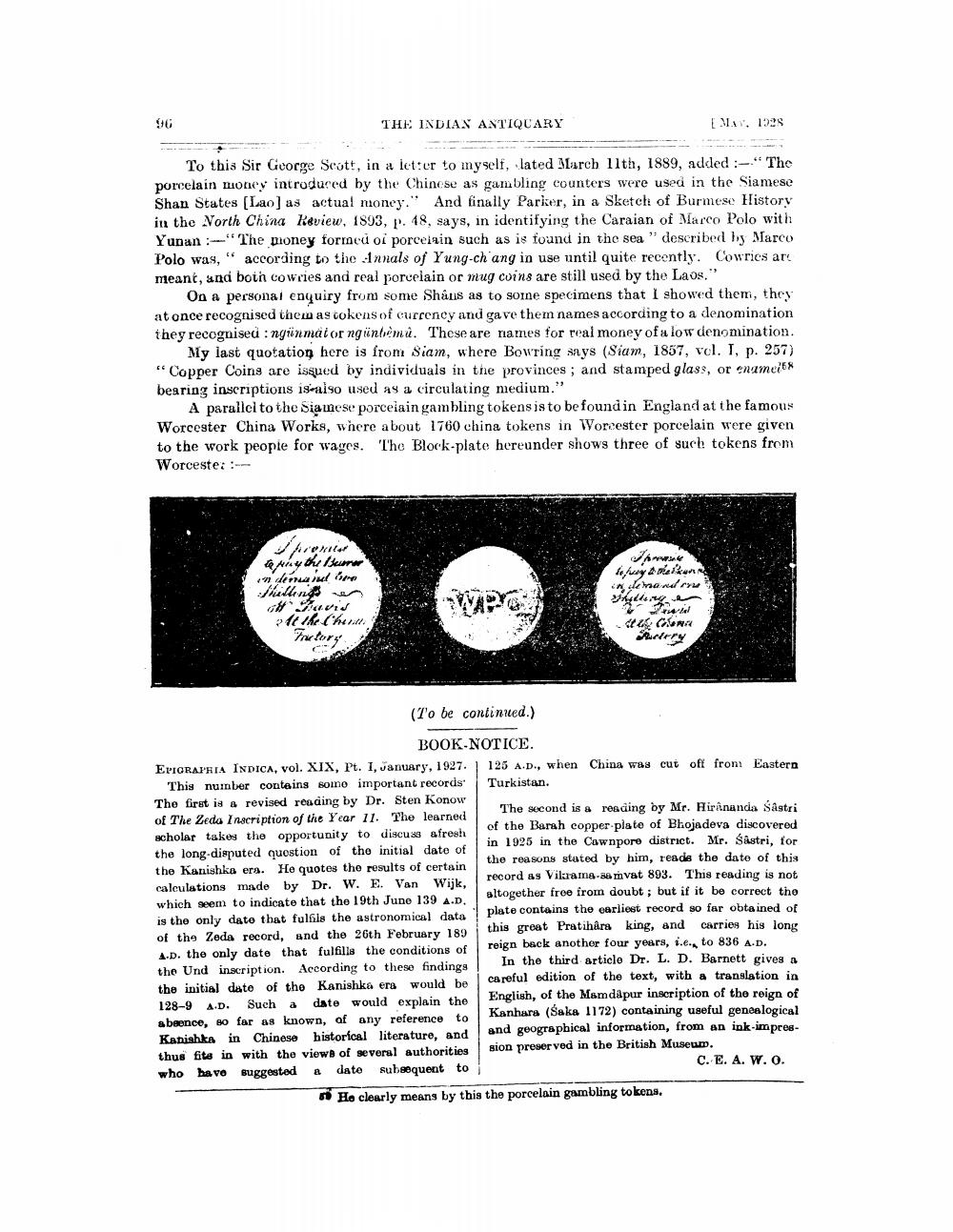________________
THE INDIAN ANTIQUARY
MAY. 1925
To this Sir George Scott, in a letter to myself, lated March 11th, 1889, added :-" The porcelain money introduced by the Chinese as gambling counters were used in the Siamese Shan States (Lao) as actual money." And finally Parker, in a Sketch of Burmese History in the North China Review, 1893, p. 48, says, in identifying the Caraian of Marco Polo with Yunan "The money formed oi porcelain such as is found in the sea " described by Marco Polo was, " according to the Annals of Yung-ch'ang in use until quite recently. Cowries are meant, and both cowries and real porcelain or mug coins are still used by the Laos."
On a personal enquiry from some Shaus as to some specimens that I showed them, they at once recognised them as tokens of currency and gave them names according to a denomination they recognised : ngiinmaior ngünbémů. These are names for real money of a low denomination.
My last quotation here is from Siam, where Bowring says (Siam, 1857, vol. I, p. 257) "Copper Coins are issued by individuals in the provinces ; and stamped glass, or enameits bearing inscriptions is also used as a circulating medium.'
A parallel to the Siamese porcelain gambling tokens is to be found in England at the famous Worcester China Works, where about 1760 china tokens in Worcester porcelain were given to the work people for wages. The Block-plate hereunder shows three of such tokens from Worceste: --
Ahy the two in deniline Tillings
the Cheville
Anne To, kunyheten in clema ndrru
han
bel
au CONA
Pretors'
(To be continued.)
BOOK-NOTICE. EPICRAPRIA INDICA, vol. XIX, Pt. 1, January, 1927. 125 A.D., when China was cut off from Eastern
This number contains somno important records Turkistan. The first is & revised reading by Dr. Sten Konow of The Zeda Inscription of the Year 11. The learned
The second is a reading by Mr. Hirananda Sastri scholar takes the opportunity to discul afresh
of the Barah copper plate of Bhojadeva discovered
in 1925 in the Cawnpore district. Mr. Sastri, for the long-disputed quostion of the initial date of
the reasons stated by him, reads the date of this the Kanishka ers. He quotes the results of certain
record as Vikrama-samvat 893. This reading is not calculations made by Dr. W. E. Van Wijk, which seem to indicate that the 19th June 139 A.D.
altogether free from doubt; but if it be correct the is the only dato that fulfis the astronomical data
plate contains the earliest record so far obtained of of the Zeda record, and the 26th February 189
this great Pratihara king, and carries his long A.D. the only date that fulfills the conditions of
reign back another four years, i.e. to 836 A.D. the Und inscription. According to these findings
In the third article Dr. L. D. Barnett gives a the initial date of the Kanishka era would be
careful edition of the text, with a translation in 128-9 A.D. Such a date would explain the
English, of the Mamdapur inscription of the reign of a bence, so far as known, of any reference to
Kanhara (Saka 1172) containing useful genealogical Kanishka in Chinese historical literature, and and geographical information, from an ink-impresthus fits in with the view of several authorities sion preserved in the British Museum. who have suggested a date subsequent to
C.E. A. W.O. Ho clearly means by this the porcelain gambling tokens.




